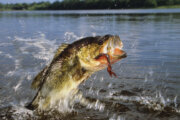If there’s one food you should be eating more often to benefit your health and the health of the planet, it is beans.
Small but mighty, beans are packed with nutrition. They are a rich source of fiber, essential vitamins and minerals, and plant-based protein. They also have the potential to feed the world and fight climate change. Beans are being heralded as such a powerful climate-positive solution that the United Nations is encouraging the world to eat more of them. The U.N. Beans Is How campaign aims to double global bean consumption by 2028, promoting beans as an affordable, delicious and sustainable ingredient that is also very versatile in the kitchen.
In the U.S., our dietary guidelines recommend eating at least a half cup of cooked beans daily, but most Americans don’t reach this goal.
Beans are part of the pulse family that also includes peas, lentils and chickpeas (or garbanzo beans). They’re the only food that does double duty — counting as both a vegetable and protein source.
While each type of bean has a different nutrition profile, beans are generally low in fat, packed with fiber (both soluble and insoluble) and contain dollar-for-dollar more protein than meat, with up to 9 grams of protein per ½ cup serving. Beans are also rich in folate, potassium, magnesium and iron.
Health Benefits of Beans
If you want to live longer, eat more beans. No other food is consistently eaten in all of the “blue zones,” or the regions of the world where people live long, healthy lives. People in the blue zones eat at least one cup of beans a day, which is more than four times as many beans as Americans eat on average.
Beans have been called the top longevity food — from chickpeas and white beans in the Mediterranean to black beans in Costa Rica and soybeans in Okinawa, Japan.
Studies suggest eating beans may help reduce multiple disease risk factors, including:
— Heart disease.
— Diabetes.
— Cancer.
— Obesity.
[See: Top Plant-Based Proteins.]
Consuming beans at least four times a week was associated with a 22% lower risk of heart disease, according to an analysis of national food consumption surveys. A 2023 meta-analysis and systematic review of 25 studies concluded that bean consumption helps reduce cardiovascular risk, with 2 cups per week providing the optimal benefits.
Beans are rich in soluble fiber, and studies indicate they may help prevent Type 2 diabetes by stabilizing blood sugar. Additional studies suggest the bioactive compounds in beans may play a role in the reduction of cancer development and progression.
Beans may also help with weight loss. A cross-sectional study of 246 women found that those who consumed moderate or high amounts of beans had less body fat and smaller waists than those with low intakes.
[See: The Best Diets for Fast Weight Loss.]
A Planet-Friendly Food
Beans are not only highly nutritious, they’re also good for the environment.
“Beans are a powerhouse for the planet, enhancing soil health by harnessing nitrogen from the air and reducing the need for synthetic fertilizers, a major contributor to air, soil and water pollution,” says Chris Vogliano, Director of Global Research at Food + Planet, a nonprofit that engages health professionals to be leaders in sustainable food systems.
Compared to other crops, beans require less water to grow, which is important since water scarcity is a growing concern. Beans are also considered low-impact compared to meat.
“Consuming beans as a protein source offers a clear environmental advantage over animal-based proteins, as they have significantly lower water footprints and emit a fraction of the greenhouse gas emissions,” says Vogliano. “Choosing beans over meat can substantially shrink an individual’s carbon footprint and contribute to a more sustainable, biodiverse food system.”
[READ: Greens Powders: Benefits, Dangers and Dietitian Recommendations]
Myths About Beans
Some people mistakenly believe beans are “fattening,” or they just didn’t grow up eating beans and don’t know what to do with them. Or perhaps there’s a concern about intestinal gas. Yet, if you increase beans gradually and include them often, rather than just occasionally, tolerance builds up, says registered dietitian Karen Collins, senior nutrition advisor to the American Institute for Cancer Research.
“Soaking dried beans for at least 8 hours or overnight and then cooking the beans in a fresh pot of water will also help,” she says. For canned beans, she recommends draining and rinsing thoroughly to remove the canning liquid.
Others may have seen misleading warnings about the “anti-nutrients” in beans called lectins. Unfortunately, this misinformation may cause some people to avoid beans. Lectins are proteins that are found in all plants that bind to carbohydrates. They help plants thrive and survive in nature, yet they can cause digestive discomfort when eaten. While all plants contain lectins, the highest amounts are found in raw beans and whole grains.
However, these warnings leave out the vital information that lectins are neutralized in cooking, says Collins. “Since lectins are water-soluble, they are largely removed by cooking or canning in water,” she says.
Since canned beans are cooked and packaged in liquid, they are low in lectins. Rinsing canned beans before eating them can remove even more lectins.
So as long as your beans are soaked and cooked, there’s no need to worry.
“Emerging research even suggests that modest amounts of lectins may play a role in supporting the immune system and is being evaluated as a potential role in cancer treatment,” says Collins.
Creative Ways to Eat More Beans
Registered dietitian, U.S. News & World Report Best Diets panelist and social media influencer Steph Grasso predicts 2024 will be the year of the bean, partially because beans are packed with fiber, which she hopes will also get the recognition it deserves this year.
Most Americans fail to get enough fiber, and she believes beans can help bridge this gap, while offering delicious, budget-friendly and versatile meal ideas.
“I love incorporating beans into my breakfast routine, whether it’s by making bean toast or mixing beans with my eggs,” says Grasso. “They’re a truly fantastic breakfast option, especially for those busy mornings when time is short,” she says.
Eating beans for breakfast doesn’t just mean a breakfast burrito or savory breakfast bowl. Instead, they can be added to smoothies, Grasso says.
“If you’re not fond of the taste, try adding white beans to a smoothie — I promise you won’t even notice them.”
Sharon Palmer, The Plant-Powered Dietitian and another U.S. News & World Report Best Diets panelist, also eats beans and other pulses daily.
“I enjoy them in salads and grain bowls, soups and stews, casseroles, wraps, pasta dishes, veggie burgers and as snacks in hummus and dips,” she says. “They are so easy and versatile.”
Palmer suggests stocking your pantry with a variety of canned beans to have on hand for the week. She also recommends dried beans, which when soaked and cooked can create delicious, simmered bean dishes.
Instead of simply a side dish, Palmer recommends making beans a bigger star of the show, such as rice and beans, bean burgers or grain bowls layered with beans and topped with a flavorful sauce.
Here are additional recipe ideas to help you eat more beans:
— Make more bean-based soups and stews including chili, minestrone, black bean, red lentil and white bean soup.
— Add whole beans, pureed or refried beans to tacos, quesadillas and burritos, such as no-cook tuna and bean wraps.
— Incorporate beans into pasta dishes, including Tuscan-style white bean pasta, pasta e fagioli with pinto or cannellini beans, and black beans in tomato sauce over spaghetti.
— Roast chickpeas and toss into salads and enjoy as a snack, or turn into a chickpea curry and serve over rice.
— Use beans in salads, such as broccoli and tomato bean salad.
— Stuff peppers with rice and beans.
— Make dips and spreads with beans, such as chickpea or white bean hummus, black bean dip and cowboy caviar, a bean-based salsa.
Easy Ways to Add More Beans to Your Diet
Maybe your experience with beans is limited to chili or three bean salad — the classic potluck dish. Go beyond these basics to discover the extensive array of beans and pulses, both dried and canned.
It’s easier than ever to enjoy beans with the introduction of new bean-forward products:
— Lentiful calls lentils “the most overlooked and underrated food in America” and they’re on a mission to change that. The company offers innovative cups of instant lentils that you simply add water, stir and microwave for a quick on-the-go lunch. Flavors include thai coconut curry and Mexican green chile.
— Eat More Beans offers convenient packages of steamed bean snacks that are ready to eat, including chickpeas, adzuki, edamame and mixed beans with black beans, kidney beans, green peas and soybeans.
— Biena has turned chickpeas into crunchy snacks. Flavors include habanero, rockin’ ranch, barbeque and honey roasted.
— Canned beans have gotten an upgrade with innovative flavors for easy meal prep, including Heyday Canning’s kimchi sesame navy beans, harissa lemon chickpeas, enchilada black beans and tomato alla vodka cannellini beans.
— The flavored canned beans at Trader Joe’s went viral on TikTok, including Greek chickpeas with parsley and cumin and giant baked beans in tomato sauce.
For more recipes and tips on how to cook beans, visit pulses.org.
More from U.S. News
What Makes a Healthy Olive Oil?
The 23 Best Low-Carb Vegetables
Sugar Free and No Sugar Snacks
Beans: Health Benefits, Recipes and Expert Advice originally appeared on usnews.com







